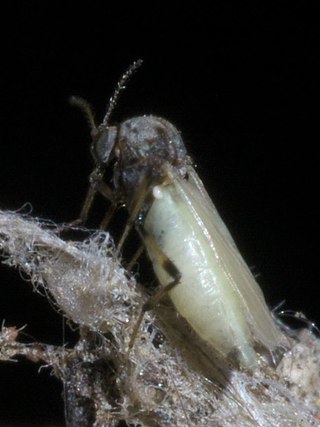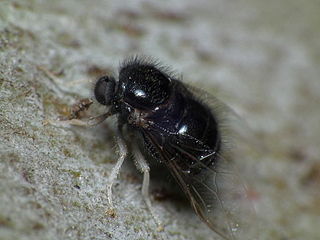
Clematis ligusticifolia is a climbing, spreading vine with showy flowers. It is also known as old-man's beard, yerba de chiva, and virgin's bower,. It is native to North America where it is widespread across the western United States in streamside thickets, wooded hillsides, and coniferous forests up to 8,500 feet (2,600 m).

Nemestrinidae, or tangle-veined flies is a family of flies in the superfamily Nemestrinoidea, closely related to Acroceridae. The family is small but distributed worldwide, with about 300 species in 34 genera. Larvae are endoparasitoids of either grasshoppers (Trichopsideinae) or scarab beetles (Hirmoneurinae). Some are considered important in the control of grasshopper populations. Adults are often observed on flowers.

Acrocerinae is a subfamily of small-headed flies in the family Acroceridae. Their larvae are endoparasites of araneomorph spiders, with the exception of Carvalhoa appendiculata which can develop as ectoparasitoids on their host spiders. Traditionally, the subfamily included the genera now placed in Cyrtinae and Ogcodinae, but the subfamily in this sense was found to be polyphyletic and was split up in 2019.
Diptera is an order of winged insects commonly known as flies. Diptera, which are one of the most successful groups of organisms on Earth, are very diverse biologically. None are truly marine but they occupy virtually every terrestrial niche. Many have co-evolved in association with plants and animals. The Diptera are a very significant group in the decomposition and degeneration of plant and animal matter, are instrumental in the breakdown and release of nutrients back into the soil, and whose larvae supplement the diet of higher agrarian organisms. They are also an important component in food chains.

Philopotinae is a subfamily of small-headed flies. They have an arched body shape, as well as enlarged postpronotal lobes that form a collar behind the head. Their larvae are endoparasites of araneomorph spiders in the subgroup Entelegynae.
Neophilopota is a genus of small-headed flies. It contains only a single species, Neophilopota brevirostris, described by Schlinger in 2013. It is endemic to Mexico.

Panopinae is a subfamily of small-headed flies (Acroceridae). Their larvae are endoparasites of spiders in the infraorder Mygalomorphae.
Coquena is a genus of small-headed fly found in Argentina and Chile. It was first established by Evert I. Schlinger in 2013.
Pialea is a genus of small-headed flies. It is known from South America.

Ogcodes is a cosmopolitan genus of small-headed flies in the family Acroceridae. About 90 species have been described for the genus. It is the most common and speciose genus in its family. These flies are endoparasitoids of ground-dwelling entelegyne spiders.
Eulonchus halli is a species of small-headed flies in the family Acroceridae. It was named after one of its original collectors, Jack C. Hall, who was also a colleague of the species's author, Evert I. Schlinger, at the University of California.

Eulonchus is a genus of small-headed flies in the family Acroceridae. There are six described species in Eulonchus. The genus is found in North America. Adults have a metallic blue, green or sometimes purple coloration, giving them a jewel-like appearance. A common name for flies in the genus is the North American jewelled spider flies. Adults are also known as "sapphires" or "emeralds".

Bezzia nobilis is a species of biting midges in the family Ceratopogonidae. It is widely considered one of the most common Bezzia species; it is found in Eurasian regions, all over the United States, Central America, and even into South American countries like Brazil. B. nobilis seem to prefer aquatic environments; they are commonly observed in stagnant water pools in Eurasia regions and marshes in the southern United States. Adults of this species are easily distinguished by their black and yellow striped legs. Pupae are recognized by their brown bodies, abdominal spines, and respiratory horns. B. nobilis larvae are distinguished by brown heads and white bodies. Little information is known on their life cycle or mating habits. B. nobilis is a predatory species. While some research suggests they mainly feed on larvae of other insect species, experiments suggest they prefer immobile, easy prey such as dead adult flies, bacteria, and protozoa.

Pterodontia is a genus of small-headed flies. There are at least 20 described species in Pterodontia.

Turbopsebius is a genus of small-headed flies in the family Acroceridae. There are about four described species in Turbopsebius.

Lasia is a genus of small-headed flies in the family Acroceridae. There are about 19 described species in Lasia, which are distributed in the New World.
Eulonchus tristis is a species of small-headed flies in the family Acroceridae.
Carvalhoa is a genus of small-headed flies in the family Acroceridae. The genus is endemic to Chile. It was originally known as Sphaerops, named by Rodolfo Amando Philippi in 1865. This name was found to be preoccupied by the reptile genus Sphaerops Gray, 1845, so it was renamed to Carvalhoa by Ahmet Ömer Koçak and Muhabbet Kemal in 2013. The genus is named after the Brazilian dipterist Claudio José Barros de Carvalho.
Eulonchus marginatus is a species of small-headed flies in the family Acroceridae. It has a Nearctic distribution and visits flowers from over ten different families.

Apsona is a genus of small-headed flies. It contains only one species, Apsona muscaria, which is endemic to New Zealand. It is very similar to the North American species Eulonchus smaragdinus.












